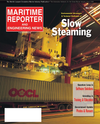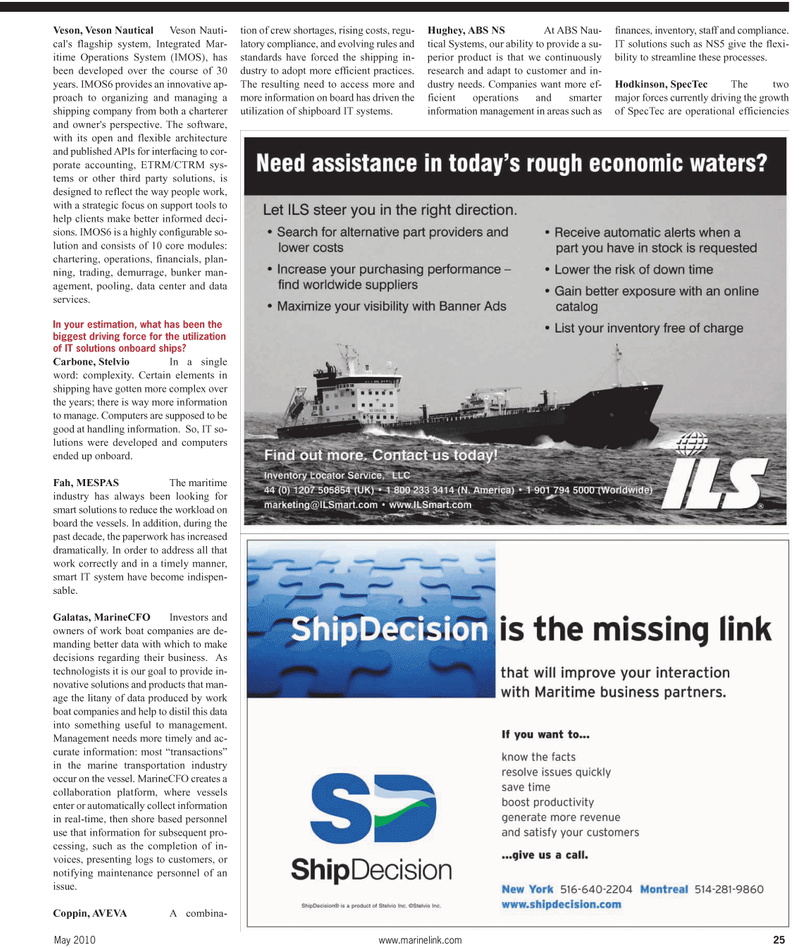
Page 25: of Maritime Reporter Magazine (May 2, 2010)
Read this page in Pdf, Flash or Html5 edition of May 2, 2010 Maritime Reporter Magazine
Veson, Veson Nautical Veson Nauti- cal's flagship system, Integrated Mar- itime Operations System (IMOS), has been developed over the course of 30 years. IMOS6 provides an innovative ap- proach to organizing and managing a shipping company from both a charterer and owner's perspective. The software, with its open and flexible architecture and published APIs for interfacing to cor- porate accounting, ETRM/CTRM sys- tems or other third party solutions, is designed to reflect the way people work, with a strategic focus on support tools to help clients make better informed deci- sions. IMOS6 is a highly configurable so- lution and consists of 10 core modules: chartering, operations, financials, plan- ning, trading, demurrage, bunker man- agement, pooling, data center and data services.
In your estimation, what has been the biggest driving force for the utilization of IT solutions onboard ships?
Carbone, Stelvio In a single word: complexity. Certain elements in shipping have gotten more complex over the years; there is way more information to manage. Computers are supposed to be good at handling information. So, IT so- lutions were developed and computers ended up onboard.
Fah, MESPAS The maritime industry has always been looking for smart solutions to reduce the workload on board the vessels. In addition, during the past decade, the paperwork has increased dramatically. In order to address all that work correctly and in a timely manner, smart IT system have become indispen- sable.
Galatas, MarineCFO Investors and owners of work boat companies are de- manding better data with which to make decisions regarding their business. As technologists it is our goal to provide in- novative solutions and products that man- age the litany of data produced by work boat companies and help to distil this data into something useful to management.
Management needs more timely and ac- curate information: most “transactions” in the marine transportation industry occur on the vessel. MarineCFO creates a collaboration platform, where vessels enter or automatically collect information in real-time, then shore based personnel use that information for subsequent pro- cessing, such as the completion of in- voices, presenting logs to customers, or notifying maintenance personnel of an issue.
Coppin, AVEVA A combina- tion of crew shortages, rising costs, regu- latory compliance, and evolving rules and standards have forced the shipping in- dustry to adopt more efficient practices.
The resulting need to access more and more information on board has driven the utilization of shipboard IT systems.
Hughey, ABS NS At ABS Nau- tical Systems, our ability to provide a su- perior product is that we continuously research and adapt to customer and in- dustry needs. Companies want more ef- ficient operations and smarter information management in areas such as finances, inventory, staff and compliance.
IT solutions such as NS5 give the flexi- bility to streamline these processes.
Hodkinson, SpecTec The two major forces currently driving the growth of SpecTec are operational efficiencies
May 2010 www.marinelink.com 25

 24
24

 26
26
